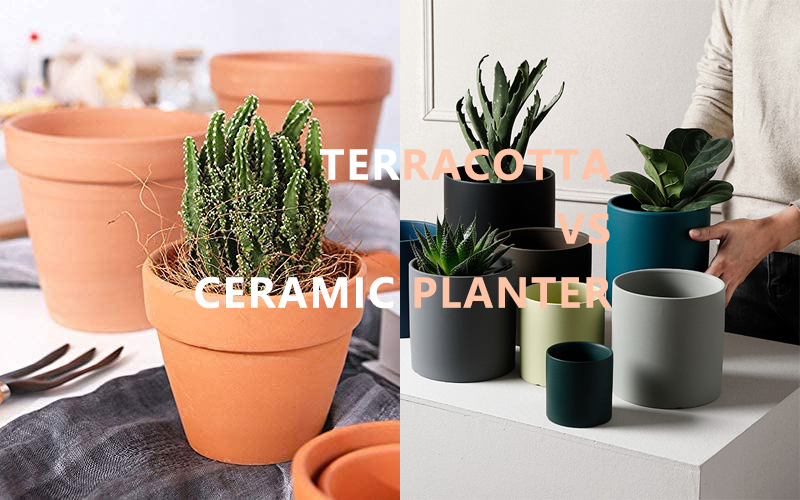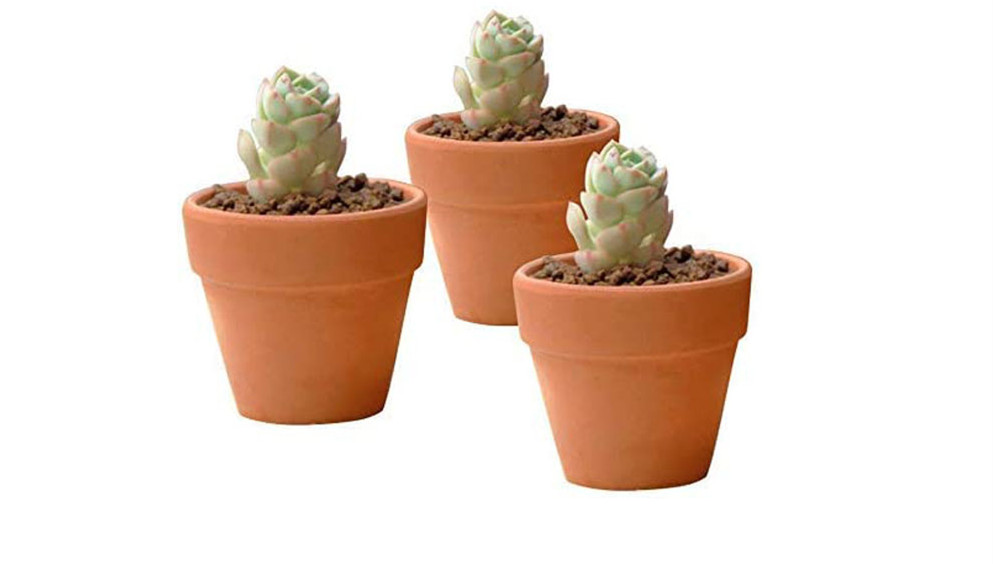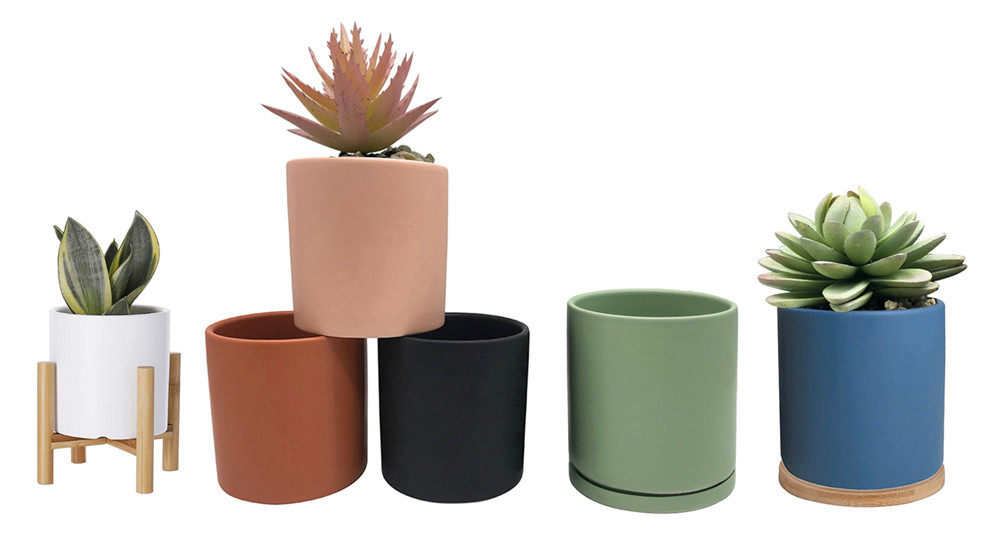Terracotta Planter vs Ceramic Planter: Latest Analytical Exploration 2024
Time of issue: 2024-01-15 14:41:52
When you want to grow plants, the first thing you have to consider is where to place the pots, indoors or outdoors, on the floor or on a table. Most terracotta flower pots are used outdoors, while ceramic flower pots are more commonly used indoors. There are reasons for this. Let?s discuss why most people use this method. But after a certain point, you look for a pot that?s durable and beautiful. This does not prove that you are old-fashioned, but it proves that you are a person who considers resources.
Ceramic planters certainly have an appealing and modern appearance, but the question arises: are they built to last? On the other hand, terracotta pots might not always catch the eye with their somewhat plain and sometimes unattractive appearance. However, it's important to note that regardless of whether you opt for ceramic or terracotta, both materials come with their own set of pros and cons that require careful consideration before you make a purchase. In this blog, we will delve into the world of terracotta and ceramic pots, exploring their characteristics and helping you determine which material suits different gardening scenarios best.
Terracotta Pots

According to a report by howstuffworks. From Latin for "baked earth," the term terracotta has been around since the 18th century. The practice of firing clay has been around much longer. If you need proof, ask the army of terracotta soldiers from northwest China that was crafted more than 2,000 years ago. Or consider the Venus of Dolni Vestonice, the oldest-known terracotta sculpture, which dates from 26,000-24,000 B.C.E.
"Terracotta refers to a low-fired, porous ceramic that has been used for millennia," explains Sarah Barack, head of conservation and senior objects conservator at Cooper Hewitt, Smithsonian Design Museum, in an email statement. ?It generally has a reddish or pink color due to the iron in the clay, which oxidizes during the firing process.?
As the material is porous, it allows air to pass, which helps to avoid problems like root rot. It can also help in draining the moisture when overwatered. However, it comes with a con as well. Sometimes, terracotta sucks all the water. To prevent it from happening, you can keep the terracotta pot in the sink full of water overnight. Then when you will use it, only the soil will take in the water. You can improve this season by keeping a Terracotta flower vase to remind you of the autumn season.
Terracotta pots have been used for centuries and are popular among gardeners and plant enthusiasts for several reasons:
1. Porosity
Terracotta is a porous material which allows air and water to pass through the pot and reach the plant's roots. The high water permeability rate ensures that excess water in the flower pot can be drained out of the flower pot. Do not let the roots soak in water.
This is also the reason why terracotta flower pots are more suitable for outdoor use. Even with the tray there was nothing to stop the water from flowing everywhere. This promotes healthy root growth and helps prevent waterlogging or overwatering.
2. Breathability
Terracotta planters have a special quality called "breathability." This characteristic is closely tied to the porous nature of terracotta, a type of clay that allows air to flow through the walls of the pot. The term "breathability" describes the pot's ability to enable the exchange of air between the external environment and the soil inside the planter.
The breathability of terracotta plant pot is incredibly beneficial for the health of your plants. It ensures that oxygen can easily reach the roots of your plants, which in turn encourages robust and healthy growth. Moreover, it prevents the soil from becoming too densely packed, a condition that can impede the development of the roots.
This feature proves especially advantageous in preventing problems like root rot, as it assists in maintaining proper aeration and drainage within the planter. In essence, terracotta flower pot become natural allies to your plants, guaranteeing that they receive the essential oxygen and airflow required for their overall well-being.
Terracotta pots provide some insulation for the plants. The clay material helps regulate temperature, keeping the roots cooler in hot weather and providing some protection against temperature fluctuations.
3. Durability
Terracotta planters are not just famous for their breathability; they also boast remarkable durability, a quality that significantly contributes to their popularity among gardeners.
This durability stems from the fact that terracotta planters are crafted from clay that undergoes high-temperature firing during the manufacturing process. This firing process results in a robust and sturdy material capable of withstanding various environmental conditions and the test of time.
However, it's worth noting that while terracotta planters generally excel in durability, they can be vulnerable to cracking in extremely cold temperatures. Therefore, it's advisable to take precautions, such as protecting them during freezing weather.
4. Affordable
Terracotta pots are more cheaper than those made from other materials like ceramic or plastic.
Ceramic Pots

According to the history of ceramic development. Throughout the 16th century CE (CE = Common Era), earthenware remained the main class of ceramic products manufactured in Europe and the Middle East. The Chinese were the first to introduce high temperature kilns capable of reaching up to 1350 degrees, and, around 600 CE, developed porcelain (a material with less than 1% porosity) from kaolin clay. During the Middle Ages, trade through the Silk Road allowed for the introduction and diffusion of porcelain throughout Islamic countries first and later in Europe, due in large part to the journeys of Marco Polo.
Ceramic flower pots are a popular choice for both indoor and outdoor gardening. They come in a wide range of sizes, shapes, and designs, making it easy to find the perfect pot to match different types of plants and your personal aesthetic preferences.
One of the appealing aspects of ceramic flower pots is their natural look and feel. Many gardeners appreciate the authenticity they bring to their gardening spaces, as ceramic pots can mimic the appearance of natural materials.
The elegance and durability of ceramic vases also make them a highly recommended option. Their graceful designs add a touch of sophistication to any garden or indoor space, while their robust construction ensures they can withstand the test of time, offering a reliable container for cherished plants.
Although ceramics are not as old as terracotta, they are still several centuries old and are very popular with gardeners and plant lovers for the following reasons:
1. Durability
Ceramic planters are celebrated for their outstanding durability. The planter crucial step in their production involves subjecting them to high temperatures. This temperature is higher than terracotta. This process yields a robust and tough material that can withstand various challenges.
What sets ceramic planters apart is their exceptional resistance to weathering and fading. This quality makes them an exceptional choice for both indoor and outdoor gardening. Come rain or shine, exposure to sunlight, or fluctuating temperatures, ceramic planters remain steadfast. They keep their structural integrity intact and retain their visual appeal. Ceramic flower pots have better cold tolerance than terracotta pots and can withstand lower temperatures
Nevertheless, it's worth bearing in mind that ceramic planters, despite their resilience, do have a potential vulnerability. They can be somewhat brittle, which means they might chip or crack if subjected to heavy impacts or accidental drops. So, while they are incredibly durable in most respects, a certain degree of care is advisable to keep them looking their best.
2. Aesthetic Appeal
- Diverse Designs: Ceramic planters come in an extensive range of sizes, shapes, and designs. Whether you prefer classic or contemporary styles, you can easily find a ceramic plant pot that suits your taste and complements your existing decor.
- Visual Charm: The natural beauty of clay, combined with the creative craftsmanship of ceramic artisans, results in planters that exude visual charm. They often feature intricate patterns, textures, and vibrant glazes that catch the eye and add character to any setting.
- Versatility: Ceramic flower pot are incredibly versatile. Their versatility allows them to seamlessly fit into various gardening or decorating themes, from rustic and traditional to modern and eclectic.
- Texture and Finish: Ceramic planters can be found in various textures and finishes, such as glossy, matte, or textured surfaces. These options enable you to choose a succulent planter that complements your specific design preferences.
- Natural Look and Feel: Many gardeners and decorators appreciate ceramic planters for their ability to mimic the appearance and texture of natural materials like stone or terracotta, adding an authentic touch to your space.
3. Moisture Retention
Ceramic pots are excellent at retaining moisture. Because of the firing temperature of ceramic flowerpots is much higher than that of terracotta flowerpots, which makes their water permeability rate much lower than that of terracotta flowerpots, and the water can be stored in the flowerpots. This eliminates the need to water plants frequently. which is particularly beneficial for plants that require a more humid environment.
Ease of Maintenance: Maintaining ceramic pots is relatively straightforward. They can be cleaned regularly with soap and water to remove dirt and debris. However, care should be taken not to scratch or damage the pot's surface during cleaning.
4. Customization
- Glazes and Finishes: Ceramic planters come in a wide variety of glazes and finishes. You can choose from glossy, matte, or textured surfaces, each offering a unique visual effect. These options enable you to match the planter's appearance to your existing decor or create a specific aesthetic theme.
- Sizes and Shapes: Ceramic planters are available in an assortment of sizes and shapes, from small round pots to large rectangular troughs. This versatility allows you to select planters that perfectly fit the space you have in mind and accommodate the growth needs of your plants.
- Designs and Patterns: Many ceramic planters feature intricate designs and patterns that can be customized to suit your taste. You can opt for planters with artistic motifs, geometric shapes, or even request custom designs to make your planter truly unique.
- Colors: Ceramic planters are available in a broad spectrum of colors. Whether you prefer vibrant hues or muted tones, you can find or request the color that best complements your overall design scheme.
- Personalization: Some ceramic planter manufacturers offer personalization options. You can have your name, a special message, or a custom logo etched or painted onto the planter's surface, adding a personal and meaningful touch to your garden or space.
- Complementary Pieces: You can also choose complementary ceramic pieces like matching saucers, trays, or decorative elements that coordinate with your planter, creating a cohesive and visually appealing display.
Conclusion
Overall, terracotta plant pots are widely favored by many gardeners because they possess a natural and timeless charm and also offer several advantages for plant health. Their classic appeal has stood the test of time, and their porous nature benefits plant roots.
On the other hand, ceramic plant pots bring both functionality and beauty to the indoor, making them a popular choice for gardening, whether it's indoors or outdoors. They excel in regulating moisture levels, ensuring your plants receive the right amount of hydration. Additionally, ceramic pots boast durability and come in a wide range of captivating designs, allowing you to enhance the visual aesthetics of your plants while simultaneously providing them with a nurturing and healthy growing environment.
RECENT POSTS
- The Benefits of Wholesale High-Quality Ceramic Products for Retailers
2025-12-17
- Can You Make an Ashtray with Air Dry Clay? Pros, Cons, and Safer Alternatives
2025-12-17
- The Impact of Ceramic Materials in Energy-Efficient Buildings: Benefits and Applications
2025-12-04
- Top 7 Ceramic Cookware Health Benefits: Why It’s a Safer Choice for Your Kitchen
2025-12-04
- How to Clean Ceramic Planters and Improve Their Lifespan?
2025-11-17
- 15 Best Ceramic Holiday Gift Ideas for 2025: Thoughtful, Elegant & Heartfelt
2025-11-17
- Stoneware vs Porcelain vs Earthenware: Quick Decision Guide
2025-10-09
- Are Ceramic Glazes Food Safe? The Truth Behind the Shine
2025-10-09










